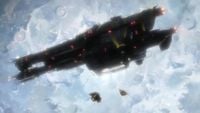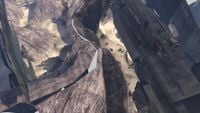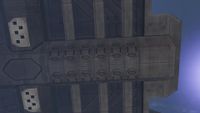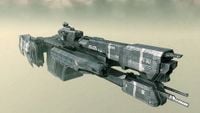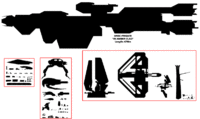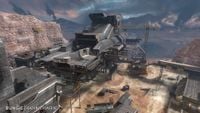UNSC frigate: Difference between revisions
From Halopedia, the Halo wiki
No edit summary |
DARKSTORM99 (talk | contribs) (Undo revision 1033515 by [[~~~~]] (talk)The UNSC Frigate dosent appear larger but the Covenant corvette is close to its size, this is a matter of perspective .) |
||
| Line 39: | Line 39: | ||
==Background== | ==Background== | ||
With current human technology, the [[UNSC]] Frigates are barely a match for even the smallest of [[Covenant]] warships. It is outrun even by smaller Covenant ships, its armor is susceptible to enemy [[pulse laser]]s and [[plasma torpedo]]s, and it is outfitted with substandard weaponry. Only ''en masse'' does the UNSC Frigate give any United Nations Space Command fleet element an advantage in the war against the genocidal Covenant. Needless to say, even a Covenant Frigate is more than a match for its UNSC counterpart | With current human technology, the [[UNSC]] Frigates are barely a match for even the smallest of [[Covenant]] warships. It is outrun even by smaller Covenant ships, its armor is susceptible to enemy [[pulse laser]]s and [[plasma torpedo]]s, and it is outfitted with substandard weaponry. Only ''en masse'' does the UNSC Frigate give any United Nations Space Command fleet element an advantage in the war against the genocidal Covenant. Needless to say, even a Covenant Frigate is more than a match for its UNSC counterpart. | ||
==Layout== | ==Layout== | ||
Revision as of 13:51, June 19, 2010
The UNSC Frigate is a warship classification in the UNSC Navy. Although it significantly lacks the amount of armor, armament, and firepower compared to its larger cousin, the UNSC Destroyer, the Frigate is smaller and thus more maneuverable. It is cheaper to produce, allowing greater numbers to be fielded against the Covenant threat.
Background
With current human technology, the UNSC Frigates are barely a match for even the smallest of Covenant warships. It is outrun even by smaller Covenant ships, its armor is susceptible to enemy pulse lasers and plasma torpedos, and it is outfitted with substandard weaponry. Only en masse does the UNSC Frigate give any United Nations Space Command fleet element an advantage in the war against the genocidal Covenant. Needless to say, even a Covenant Frigate is more than a match for its UNSC counterpart.
Layout
The bridge of the Frigate is located in the uppermost part of the ship, in the section at the stern-most tip of the MAC gun shaft (in the case of the only seen version of the UNSC frigate, there is another layout variation similar in appearance to the Halcyon-class Cruiser, Template:UNSCship). The Commanding Officer's chair is located behind the two primary consoles within the bridge. There are numerous other consoles located at the sides of the room. There are four bridge stations: Navigation, Operations, Weapons, and Communications.
UNSC Frigates also possess 12 HEV Bays, located in the rear of the ship, which facilitates the deployment of ODST's.
UNSC Frigates (specifically the Template:UNSCship, Template:UNSCship and Template:UNSCship) are capable of hovering in an atmosphere and possibly landing. They also have either a garage or cargo bay in their rear section which is capable of extending out of the ship's ventral side to deploy vehicles or cargo directly to the ground.[1][2] Frigates are seen carrying 3 Pelican Dropships in the rear section.
Specifications
Dimensions
A typical Frigate of 2552 appears to be around 478 metres (1,570 ft) long, 151 metres (500 ft) wide and 112 metres (370 ft) tall. It is one of the smallest warships fielded by the UNSC.
Propulsion
Like other Human ships, the UNSC frigate is powered by thermonuclear fusion reactors which use deuterium (a stable hydrogen isotope) as fuel. The engines almost certainly use the energy obtained from this process to heat some form of reaction propellant which is expelled out of rear-facing exhausts to generate thrust. There are four exhausts visible on frigates; two large and two small.
For translight voyages, the Frigate carries a Shaw-Fujikawa Translight Engine. Although they cannot be seen, it can be safely assumed that frigates also possess multiple maneuvering thrusters to adjust a vessel's attitude in three dimensions. Finally, frigates have several times been observed to hover in an atmosphere. It is possible that they vector thrust downward in order to accomplish this feat, but no downward-pointing exhaust nozzles are visible. It is more likely that they employ some form of Covenant-derived antigravity mechanism, or perhaps electrostatic or magnetic levitation.
Armament
A typical UNSC Frigate carriers the following armament:
- 1 MAC Cannon which is able to fire one round per charge. The MAC takes up between one and two thirds of a frigate's total length.
- 3 Shiva Nuclear Missiles are the ships' heavy ordnance.
- 40 Archer Missile Pods which would carry around thirty missiles per pod, adding up to a total of 1200 missiles.
- 50mm point defense guns which would function as the last line of defense against incoming missiles or single ships.
- 5 Defensive Railgun Turrets[3]
Crew
No precise figures are available regarding the crew of a Frigate, but it is likely relatively small, (maybe a few hundred would be stationed in a Frigate). Like larger ships, a detachment of Marines and sometimes ODSTs would be present onboard. The crew number includes deck crews as well as the command crew, Marines, ODST's, Pelican Pilots and technical personnel. The number of personnel a single frigate is capable of housing numbers at least in the thousands.[4]
In 2552 Sergeant Major Avery Johnson was supposedly able to single-handedly control the frigate Forward Unto Dawn to help out John-117 and Arbiter Thel Vadam on the newly rebuilt Halo, though this may have been a kind of auto-pilot function. Naturally, an AI can monitor and regulate all critical functions single-handedly.
Superstructure
The armor of a Frigate is relatively poor compared to that of its larger cousins and counterparts such as the UNSC Destroyer with just 60 cm of battle plate. However, due to it being relatively lightweight, the Frigate's strength lies instead in maneuverability and speed. In addition, over the decades that the war has gone on, Frigates needed refits and they could have been given more armor overtime. The Forward Unto Dawn and the In Amber Clad look very different from some angles but are still classified as Frigates.
The Frigate's relatively wide design is supported by structural support ribs, allowing it to perform orbital incursions [5].
Squadrons
Based on observations made in Halo 3 (And Battle Group D at Harvest), It may be assumed that frigates tend to operate in groups of 3. This would allow one ship to fire it's MAC while the other is charging, and still leaving the third vessel to provide close support. Also, based off of the troop compliment of each frigate, Each squadron would carry one regiment of Marines and one battalion of ODST's, a suitable ground compliment for a three ship task force, and a comparable structure used by marine units today. Since the UNSC individually numbers Marine Regiments and ODST Battalions, it can be assumed these units are given some form of autonomy to be deployed apart from any larger 'parent' unit, thus being suitable for such a posting
Known Frigates
Gallery
UNSC Aegis Fate over Sandtrap (FFG-307).
UNSC In Amber Clad in High Charity (FFG-142).
- New frigate.jpg
UNSC Forward Unto Dawn (FFG-201).
Frigate firing a round from its Magnetic Accelerator Cannon.
- 10203554-Full.jpg
The Archer Pods of the Forward Unto Dawn.
- Navesota.jpg
Template:UNSCship (FFG-307)
- Reach friggit wreck.png
A destroyed Frigate over Reach.
- ArabiaVostok.png
UNSC Arabia and UNSC Vostok being destroyed at the First Battle of Harvest.
A UNSC Frigate, the Commonwealth, being taken apart, partially showing the ship's internal structure.
Links
External
Sources
- ^ Halo 2
- ^ Halo 3, level The Ark
- ^ Art of Halo 3
- ^ Halo: First Strike, page ??
- ^ Art of Halo 3

